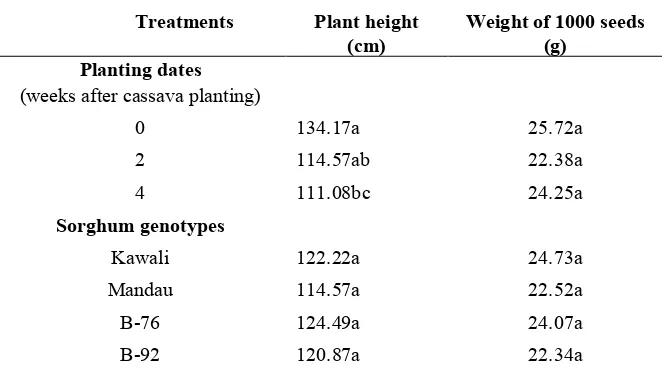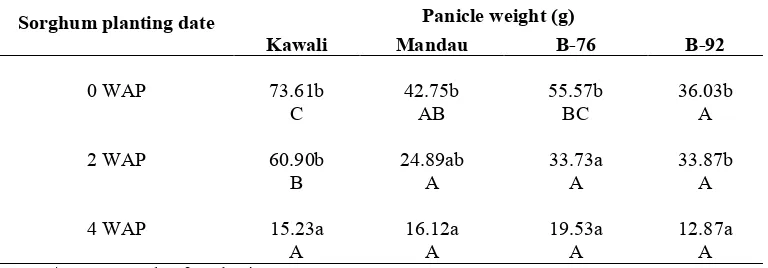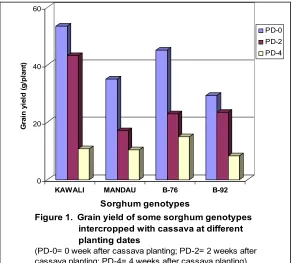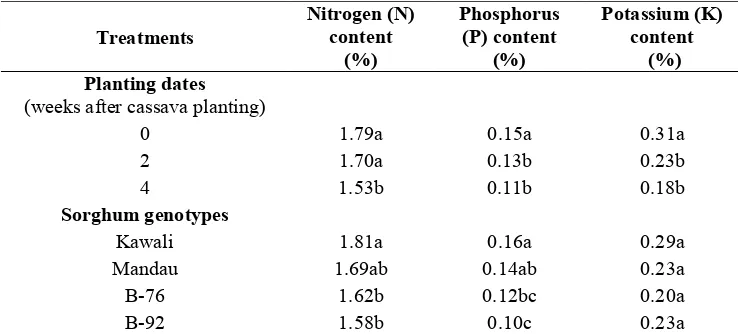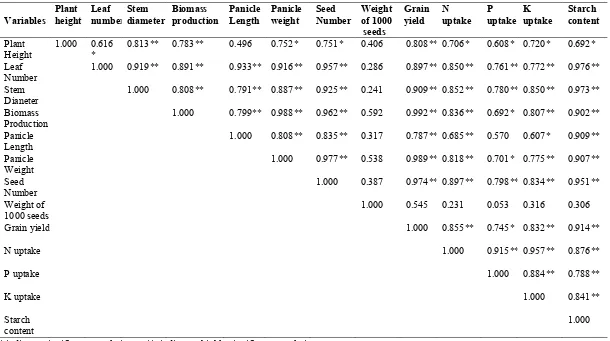64
GRAIN YIELD AND, NUTRIENT AND STARCH CONTENT OF SORGHUM
(
Sorghum bicolor
(L.) Moench) GENOTYPES AS AFFECTED BY DATE OF
INTERCROPPING WITH CASSAVA IN LAMPUNG, INDONESIA
M. Kamal1, M.S. Hadi1, E. Hariyanto2, Jumarko2 and Ashadi2
1
Faculty of Agriculture, University of Lampung, Bandar Lampung 35145 , Indonesia
2
Government Office of East Lampung District, Lampung Province, Indonesia Corresponding author: [email protected]
(Received: December 12, 2013; Accepted: May 10, 2014)
ABSTRACT
Sorghum (Sorghum bicolor (L.) Moench) is one of the cereal crops utilized as source of food, feed and bioethanol production. Intercropping with cassava is a promising means of developing sorghum plants in Lampung province of Indonesia. However, little information on sorghum intercropped with cassava has been documented. The study sought to evaluate the effect of planting dates on grain yield and content N, P, K and seed starch of several sorghum genotypes intercropped with cassava. A field experiment was conducted in Waway Karya of East Lampung, Lampung Province-Indonesia in 2009-2010. The treatments were arranged factorially with split-plot in randomized block design with three replications. The main plot was planting dates consisting of three levels, that was, 0, 2 and 4 weeks after planting cassava. Sub-plot was sorghum genotypes including Kawali, Mandau, B-76 and B-92. Fertilizers used were urea, SP-36 and KCl. Sorghum plants were intercropped with cassava and planted in interrows of cassava, while cassava was planted with row spacing of 80 cm x 60 cm. Sorghum plants intercropped with cassava and planted at 2 and 4 weeks after planting cassava resulted in lower grain yield and content of nutrient and seed starch compared to that planted at the same date of cassava planting. The highest reduction occured at the planting date of 4 weeks after planting cassava, that was, 72.9% for sorghum grain yield. The reduction in N, P and K content of sorghum plants caused by 4-weeks delayed planting was 14.5, 26.7 and 41.9%, respectively, while the reduction of seed starch content was only 6.0%.
Key words: cassava canopy, competition, nutrient content, panicle, planting date, shade, starch
INTRODUCTION
65
Lampung is one of provinces in Indonesia located in Sumatra Island. Agricultural land in Lampung is dominated by upland agriculture, so lack of water frequently limit crop productivity. Food crops such as rice, corn and cassava are major food crops in Lampung-Indonesia and are cultivated mostly in monoculture systems. Actually, intercropping cassava with other food crops is still possible since growth and development of cassava canopy at early growth stages are very slow (Kamal, 2009). On the other hand, slow growth of cassava canopy at early stage potentially creates the problem of soil erosion and weed control. Coolman and Hoyt (1993) reported that intercropping could be more eficient than monoculture in utilizing limited resources. Moreover, intercropping systems are frequently effective to reduce damage associated with insect and pathogen attacks besides weed control. Lithourgidis et al. (2011) indicated that intercropping is an alternative way for sustainable agriculture.
Ecologically, sorghum plants could grow in wide ranges of environmental conditions. Sunyoto and Kamal (2009) reported that sorghum could grow well under agroclimate conditions of Lampung-Indonesia although their yield was affected by planting dates and sorghum genotypes. In general, sorghum that is cultivated in the dry season produces higher yield compared to that cultivated in wet (rainy) season. The study reported by Netondo et al. (2004) indicated that sorghum plants are relatively highly tolerant to drought. Thus, it could be used for optimizing biomass production in upland agriculture frequently subjected to water shortage.
Sorghum plants basically could be cultivated on monoculture and intercropping systems. However, the development of sorghum in Lampung- Indonesia by monoculture system will face the problem of land use competition with other food crops such as rice, corn and cassava. Thus, intercropping is a promising means of developing sorghum plants in Lampung-Indonesia, especially intercropped with cassava. Lampung is the biggest cassava producer in Indonesia, accounting for more than 30 % of Indonesian cassava production (BPS, 2012). Many reports show that sorghum plants could be intercropped with corn, soybean, cowpea and peanut (Langat et al., 2006; Mohammed et al. 2006; Egbe, 2010; Musa et al. 2011). However, little information about intercropping sorghum plants with cassava was documented. Hamim et al. (2012) reported that planting time of sorghum on intercropping with cassava determines sorghum grain yield.
This study sought to evaluate the effect of planting dates on grain yield and content of N, P, K and seed starch of several sorghum genotypes intercropped with cassava.. Better understanding of morphophysiology of sorghum plants intercropped with cassava would be useful in developing sorghum plants through intercropping.
MATERIALS AND METHODS
Experimental Site
The field experiment was conducted in the district of Waway Karya, East Lampung, Lampung Province, Indonesia in 2009-2010. The experimental site was located 70 m above sea level with a rainfall of 120 mm month-1, and it was considered as rain-fed agricultural land with the soil pH of 5.8.
Experimental Design
66
The treatments consisting of planting dates and sorghum genotypes were arranged in factorial with split plot in Randomized Complete Block Design with three replications. The main plot was sorghum planting dates, while the sub-plot was sorghum genotypes. Planting dates consisted of three levels, that was, 0, 2 and 4 weeks after planting cassava. Sorghum genotypes consisted of Kawali, Mandau, B-76 and B-92.
Cultural Practice
Before planting, soil was sprayed by herbicide (glyphosate) with the dosage of 2 L ha-1. One week later, soil was plowed and plotted. Each plot was 5 by 4 m in size, and interplot had the distance of 60 cm. Cassava was planted with row spacing of 80 cm x 60 cm, so each plot had 6 rows of cassava. The dosage of urea, SP-36 and KCl was 300, 100 and 100 kg ha-1, respectively. Urea and KCl were split; ½ dosage was applied at 3 weeks after planting, and another half-dosage was applied at 14 weeks after planting. SP-36 was applied once at 3 weeks after planting. During the experiment, pesticide was not used to controll pest and disease in cassava.
Sorghum seeds were planted in each plot manually after planting cassava. Sorghum were planted as an intercrop between cassava rows with the distance of 20 cm in rows , and the distance of cassava and sorghum rows was 40 cm. The number of sorghum rows in each plot was 5 rows and each of which had 24 hills.
Sorghum plants intercropped with cassava were planted in different planting dates, that was, the same time of planting cassava (0 week), 2 weeks after planting cassava (2 WAP) and four weeks after plating cassava (4 WAP). The dosage of urea, SP-36 and KCl was 200, 100 and 100 kg ha-1, respectively. SP-36 and KCl were applied once at 2 weeks after planting, while Urea was splitted, that is, ½ dosage was applied at 2 weeks after planting and another half-dosage was applied at 5 weeks after planting. During the experiment sorghum plants sometimes were irrigated to prevent them from water stress. Pest and diseases were controlled by pesticide application. Aphids and leaf blight were observed although their attack was relatively light.
Data Collection and Analysis
The variables observed were plant height, leaf number, stem diameter, biomass production, panicle length, seed number, seed size, grain yield, of N, P and K content in sorghum leaves, and seeed starch content. For nutrient analysis, sorghum leaves were sampled at maturity (harvesting time). The content of N was determined by Kjeldahl method, while P content was determined by spectrophotometry (Spectronic 20- Milton Boy Co.) and the reading was taken at 693 nm. K content was determined by flame photometry (Model PFP7-Jenway). Nutrient analysis was according to the method described by Agus et al. (2005).
Starch content was analyzed by a modified Somogy method as explained before (JICA, 1983). Ten grams of sorghum seed powder was placed in a 300 mL Erlenmeyer flask where 20 mL of HCl (25%) and 200 mL distilled water were added. The Erlenmeyer flask was closed and allowed to hydrolyze for 2-3 minutes. The solution was neutralized by adding NaOH (20%) until the pH of 6.8-7.0 was reached. The solution was diluted 500—1000x and 10 mL of sample was placed into a 100-mL Erlenmeyer flask where 10 100-mL of Reagent A and 10 100-mL of distilled water were added. The solution was allowed to boil for 3 minutes and left to cool. Thereafter, 10 mL of reagent B and 10 mL of Reagent C and some drops of amylum indicator (1%) were added. Finally, the sample was titrated by using Na2SO3 0.1 N solution. Based on the amount of Na2SO3 0.1 N used, starch content was
calculated (JICA, 1983).
67
RESULTS AND DISCUSSIONS
Sorghum growth
The results of the experiment revealed that planting dates significantly influenced growth of sorghum plants intercropped with cassava although its effect depended on sorghum genotypes. Planting dates of 2 and 4 weeks after planting cassava resulted in lower plant height (Table 1), leaf number (Table 2), stem diameter (Table 3) and biomass production (Table 4) compared to that in the planting date of 0 week (the same date of planting cassava).
In general, the delay of sorghum planting dates up to 2 and 4 weeks after planting cassava reduced plant height, leaf number, stem diameter and biomass production although the magnitude of reduction depends on sorghum genotypes, especially at 2 WAP. However, at 4 WAP all sorghum genotypes showed great inhibition and no significant growth difference. The reduction of sorghum growth in intercropping with cassava was most likely due to interspecific competition. At the planting dates of 2 and 4 weeks after planting cassava, the development of cassava canopy exceeded sorghum plants. Thus, sorghum plants suffered from low light intensity caused by shade of cassava canopy, which in turn reduced sorghum growth.
Similar results were reported by Hamim et al. (2012) indicating the reduction of sorghum growth in intercropping with cassava, while Suwarto et al. (2005) reported the reduction of maize growth in intercropping with cassava. Mouneke et al. (2007) also reported that the difference in canopy development frequently creates interspesific competition for sunlight in intercropping systems, resulting in growth inhibition.
In terms of sorghum genotypes, Kawali consistently showed the superiority of plant height, leaf number, stem diameter and biomass production compared to other sorghum genotypes.
Table 1. Effect of planting dates and genotypes on plant height and weight of 1000 seeds of sorghum plants intercropped with cassava
Treatments Plant height (cm)
Weight of 1000 seeds (g)
Planting dates (weeks after cassava planting)
0 134.17a 25.72a
2 114.57ab 22.38a
4 111.08bc 24.25a
Sorghum genotypes
Kawali 122.22a 24.73a
Mandau 114.57a 22.52a
B-76 124.49a 24.07a
B-92 120.87a 22.34a
68
Table 2. Leaf number of different sorghum genotypes as affected by date of intercropping with cassava
Sorghum planting date Leaf number (number per plant)
Kawali Mandau B-76 B-92 * WAP = weeks after planting cassava
** The numbers followed by the same-small letters in the same column and the same capital letter in the same rows are not significantly different with LSD test at P=0.05.
Table 3. Stem diameter of different sorghum genotypes as affected by date of intercropping with cassava
Sorghum planting date Stem diameter (cm)
Kawali Mandau B-76 B-92 * WAP = weeks after planting cassava
** The numbers followed by the same-small letters in the same column and the same capital letter in the same rows are not significantly different with LSD test at P=0.05.
Table 4. Biomass production of different sorghum genotypes as affected by date of intercropping with cassava
Sorghum planting date Biomass production (g/plant)
Kawali Mandau B-76 B-92 * WAP = weeks after planting cassava
69 Sorghum yield component and grain yield
The interaction effect of planting dates and genotypes on yield components of sorghum plants intercropped with cassava was also found (Table 5, 6 and 7). The performance of sorghum yield components planted at 2 and 4 weeks after planting cassava were lower than that planted at 0 WAP although the magnitude of the reduction depends on sorghum genotypes, especially at 2 WAP. On the average, the reduction of panicle length, panicle weight and seed number caused by the delay of sorghum planting dates of 2-4 WAP was 3.5-19.1%, 26.2-69.3% and 25.1-71.3%, respectively. It seems that seed number was the most sensitive sorghum yield component to shading caused by cassava canopy. In contrast, weight of 1000 seeds was not significantly affected by planting dates of sorghum plants intercropped with cassava (Table 1). This is in agreement with the previous study reported by Hamim et al. (2012). The result of the study reported by Kamal (2007) indicated that the treatment of 50% shade suppressed growth and development of rice yield components. The reduction of sorghum yield components caused by 2- and 4-week delayed planting was related to the inhibition of sorghum growth. As mentioned earlier, the canopy of cassava created shading on sorghum plants, which in turn, reduced photosynthetic rate and resulted in lower assimilate supply for sorghum yield component development.
Table 5. Panicle length of different sorghum genotypes as affected by date of intercropping with cassava
Sorghum planting date Panicle length (cm)
Kawali Mandau B-76 B-92 * WAP = weeks after planting cassava
** The numbers followed by the same-small letters in the same column and the same capital letter in the same rows are not significantly different with LSD test at P=0.05.
Table 6. Panicle weight of different sorghum genotypes as affected by date of intercropping with cassava
Sorghum planting date Panicle weight (g)
Kawali Mandau B-76 B-92 * WAP = weeks after planting cassava
70
Table 7. Seed number of different sorghum genotypes as affected by date of intercropping with cassava
Sorghum planting date Seed number (no. panicle-1)
Kawali Mandau B-76 B-92 * WAP = weeks after planting
** The numbers followed by the same-small letters in the same column and the same capital letter in the same rows are not significantly different with LSD test at P=0.05.
Since adequate supply of assimilate was highly required for sorghum grain filling (Huang and Ma 1995), the reduction of assimilate supply caused by shading decreased sorghum grain yield. Thus, it is not surprising that sorghum grain yield at 2 and 4 weeks after planting cassava was lower than that at the planting date of 0 week (Fig. 1).
Figure 1. Grain yield of some sorghum genotypes intercropped with cassava at different planting dates
(PD-0= 0 week after cassava planting; PD-2= 2 weeks after cassava planting; PD-4= 4 weeks after cassava planting)
PD-0 PD-2 PD-4
71
Interestingly, Kawali also showed less reduction of grain yield at the planting date of 2 weeks after planting cassava compared to other shorgum genotypes.
However, at the planting date of 4 weeks after planting cassava all sorghum genotypes indicated similar reduction of grain yield. This means that depressive effects of cassava on sorghum grain yield at 4 WAP was much more pronounced than that at 2 weeks after planting cassava. Thus the delay of sorghum planting dates up to 4 weeks after planting cassava was not recommended in intercropping systems of sorghum and cassava.
Nutrient and starch content
The planting dates of sorghum intercropped with cassava significantly influenced N, P and K nutrient levels (Table 8), while the interaction effect of planting date and sorghum genotype on nutrient content was not significant. The planting dates of 2 and 4 WAP consistently resulted in lower content of N, P and K compared to that at the planting date of 0 WAP. This reduction of nutrient content was most likely attributed to the inhibition of sorghum growth caused by the delay of sorghum planting dates in intercropping with cassava. Epstein and Bloom (2005) reported that the inhibition of plant growth can lead to the inhibition of nutrient uptake since nutrient uptake is related to plant metabolism (Mengel and Kirby, 1987). The differences in sorghum genotypes also resulted in nutrient content differences (Table 8). Many studies showed that nutrient uptake is affected by genetic factors (Mengel and Kirby, 1987; Kamoshita et al., 1995; Hirei et al., 2001; Setiawan and Kamal, 2008). Sorghum genotype of Kawali also demonstrated superiority of N and P content compared to other sorghum genotypes (Table 8).
Table 8. Effect of planting dates and genotypes on nutrient content of sorghum plants intercropped with cassava
Treatments
Nitrogen (N) content
(%)
Phosphorus (P) content
(%)
Potassium (K) content
(%) Planting dates
(weeks after cassava planting)
0 1.79a 0.15a 0.31a
2 1.70a 0.13b 0.23b
4 1.53b 0.11b 0.18b
Sorghum genotypes
Kawali 1.81a 0.16a 0.29a
Mandau 1.69ab 0.14ab 0.23a
B-76 1.62b 0.12bc 0.20a
B-92 1.58b 0.10c 0.23a
* The numbers followed by the same letters in the same columns and treatments are not significantly different with LSD test P=0.05.
72
with shading in rice plants indicates that rice plants grown under shade condition produces less starch compared to rice plants grown under full-sun condition (Laut et al., 2000), while Huber and Israel (1982) reported that changes in starch and sucrose content under shade are related to the activity of SPS enzyme which catalyzes the synthesis of sucrose-P from UDP Glucose. Among sorghum genotypes, Kawali showed the highest seed starch content compared to other genotypes (Fig. 2), suggesting that Kawali consistently indicates the superiority of growth, nutrient uptake, yield components, grain yield and starch content.
Compared to grain yield reduction caused by the delay of planting dates (Fig. 1), the reduction of starch content in sorghum seeds at the planting dats of 2 and 4 weeks after planting cassava was lower (Fig. 2). This is related to grain-developing process which involves yield component formation and development. Thus, the reduction of sorghum yield components such as panicle weight and length, and seed number result in lower grain yield. In terms of seed starch content, the amount of assimilate produced during grain filling is critical since the number of sorghum seeds is already set earlier. Huang and Ma (1995) stated that the dry matter accumulation in shorghum seeds was mostly supplied by the assimilate produced during reproductive stage. Thus, the difference of starch content in shorghum seeds was not as big as the difference in grain yield.
From the stand point of nutrient uptake, the reduction of sorghum grain yield caused by the delay of sorghum planting dates of 2 and 4 weeks after planting cassava (Fig. 1) was in parallel with the reduction of N, P and K content caused by 2- and 4-week delayed planting (Table 8). The result of correlation analyses revealed that sorghum grain yield was highly correlated with N(r=0.855**), P(r=0.745**) and K(r=0.832**) uptake.
0 30 60 90
S
ta
rc
h
c
o
n
te
n
t
(%
)
KAWALI MANDAU B-76 B-92
Sorghum genotypes
Figure 2. Starch content in sorghum seeds intercropped with cassava at different planting dates
(PD-0= 0 week after cassava planting; PD-2= 2 weeks after cassava planting; PD-4= 4 weeks after cassava planting)
PD-0 PD-2 PD-4
73
Table 9. Correlation coefficient of growth variabel with yield components, nutrient uptake and starch content of sorghum plants intercropped with cassava
74 CONCLUSION
Sorghum plants intercropped with cassava and planted at 2 and 4 WAP resulted in lower grain yield and content of nutrient and seed starch compared to that planted at the same date of cassava planting (0 WAP). Intercropping at 2 and 4 WAP reduced sorghum grain yield, sorghum seed starch content and N, P and K content. But the reduction of sorghum yield component planted at 2 WAP depended on sorghum genotypes. Sorghum plants could be intercropped with cassava as long as they were planted at the same date of cassava planting. The sorghum genotype of Kawali showed the highest grain yield and content of nutrient and seed starch content. It seems that the reduction of sorghum grain yield, nutrient uptake and seed starch content caused by 2- and 4 week-delayed planting in intercropping with cassava was related to shading caused by cassava canopy development.
ACKNOWLEDGEMENT
We would like to thank to STIPER SURYA DHARMA and BPPT Lampung for technical assistance and financial support for this experiment. We also greatly thank the reviewers of J. ISSAAS.
REFERENCES
Agus, F., Sulaeman, Suparto and Eviati. 2005. Petunjuk Teknis Analisis Kimia Tanah, Tanaman, Air dan Pupuk. Balai Penelitian Tanah Badan Pengembangan Pertanian Departemen Petanian, Bogor.
Ali, M.A., A. Abbas, S.I. Awan, K. Jabran and S. D.A. Gardesi. 2011. Correlated response of various morpho-physiological characters with grain yield in sorghum landraces at different growth phases. Journal of Animal &.Plant Sciences 21(4):671-679.
BPS. 2012. Luas Panen-Produktivitas-Produksi Tanaman Ubi Kayu di Indonesia.
http://www.bps.go.id/tnmn_pgn.php
Coolman, R.M. and G.D. Hoyt. 1993. Increasing sustainability by intercropping. Hort Tech. 3(3):309-312.
Egbe, O.M. 2010. Effects of plant density of intercropped soybean with tall sorghum on competititive ability of soybean and economic yield at Otobi, Benue State, Nigeria. J. Cereals and Oilseeds 1(1):1-10.
Epstein, E. and A.J. Bloom. 2005. Mineral Nutrition of Plants: Principles and Prespectives. Second Ed. Sinauer Associates Inc., Sunderland, Massachusetts. 400 p.
Huber, S.C. and D.W. Israel. 1982. Biochemical basis for partitioning of photosynthetically fixed carbon between starch and sucrose in soybean (Glycine max Merr.) leaves. Plant Physiol. 69:691-696.
75
Hirei, B., P. Berrtin, I. Quillere, W. Bourdonele, C. Attagnant, C. Dellay, A. Gaouy, S. Cadiou, C. Retalian, M. Falque and A. Gallas. 2001. Towards better understanding of the genetic and physiological basis for nitrogen use efficiency in maize. Plant Physiol. 1258-1270.
Huang, R.I. and H. Ma. 1995. Comparison of dry weight accumulation patterns between maize and sorghum. Proc.2nd Asian Crop Sci.Conf., The Fukui Perfecture Univ., Fukui, Japan. Pp 290--293
JICA. 1983. Ethanol Production From Cassava for 8 KL/day. Jakarta, Indonesia.
Kamal, M. 2007. The tolerance of several genotypes of upland rice to shading at different growth stages. J. Agrista 11(1):29-35.
Kamal, M. 2009. Tuber growth and starch content in cassava as affected by potassium (K) application at different planting dates. Pros.Sem.Hasil Penel.Peng. Lemlit Universitas Lampung, Bandar Lampung. Pp B-61—65.
Kamoshita, A., S. Fukai and R.C. Muchow. 1995. Genotypic variation, and genotype by N interaction for yield and grain N concentration in grain sorghum in sub-tropical Australia. Proc.2nd Asian Crop Sci.Conf., The Fukui Perfecture Univ., Fukui, Japan. Pp 474-475.
Laut, B.S., M.A. Chozin, D. Sopandie and L.K. Darusman. 2000. Starch-sucrose balance and sucrose phosphate synthase enzyme activity in upland rice tolerance and sensitive to shading. Hayati 7(1):31-34.
Lithourgidis, A.S., C.A. Dordas, C.A. Damalas, and D.N. Vlachostergios. 2011. Annual intercrops: an alternative pathway for sustainable agriculture. Australian Journal of Crop Science (AJCS)5(4):396-410.
Longat MC., Okiror MA., Ouma JP., and Gesimba RM. 2006. The effect of intercropping groundnut (Arachis hypogea L.) with sorghum (Sorghum bicolor L. Moench) on yield and cash income. Agric.Tropica ET Subtropica. 39(2):87-91.
Mengel, K. and E.A. Kirby. 1987. Principles of Plant Nutrition. Internantional Potash Institute Publ., Switzerland. 676 p.
Mohammed, I.B., O.O. Olufajo, B.B. Singh, S. Miko and S.G. Mohammad. 2008. Evaluation of yield of components of sorghum/cowpea intercrops in the Sudan Savana Ecological Zone. ARPN
J.Agric.Biol.Sci. 3(3):30-37.
Mouneke, C.O., M.A.O. Ogwuche and B.A. Kalu. 2007. Effect of maize planting density on the performance of maize/soybean intercropping systems in a guinea savana agroecosystem. Afr. J. Agric. Res. 2:667-677.
Musa, E.M., E.A.E. Elsheikh, I.A.M. Ahmed and E.E. Babiker. 2011. Intercropping sorghum (Sorghum bicolor L.) and cowpea (Vigna unguiculata L.): Effect of Bradyrhizobium innoculation and fertilization on minerals composition of cowpea seeds. Intl.J. Agric. Res. Rev. 1(3):138-146.
76
Rooney, L.W. and R.D. Waniska. 2000. Sorghum food and industrial utilization. pp.689-729. In Smith C.W. and RA. Frederiksen (Eds.) Sorghum:Origin, History, Technology and Production. John Wiley and Sons Inc., New York.
Setiawan, K.and M. Kamal. 2008. The content of N, P, K and Mg at vegetative stage and its relation to growth and seed yield of upland rice. J. Ilmiah Pertanian. Gakuryoku XIV:55-59.
Sunyoto and M. Kamal. 2009. Penampilan agronomi berbagai genotip sorgum (Shorgum bicolor (L.) Moench) di Bandar Lampung sela dua musim tanam. Pros.Sem.Nas. Teknologi Tepat guna Agroindustri dan Diseminasi Hasil penelitian Dosen Polinela, Bandar Lampung, April 2009. (In Bahasa Indonesia)
Suswono. 2012. Kebijakan kementrian pertanian dalam penyediaan lahan dan teknologi untuk mendukung terwujudnya kedaulatan pangan. Pros. Sem. Bersama Peragi-Perhorti-Peripi-Higi. Mendukung Kedaulatan Pangan dan Energi yang Berkelanjutan. Departemen Agronomi dan Hortikultura Fakultas Pertanian Institut Pertanian Bogor, Bogor, 1-2 Mei 2012. (In Bahasa Indonesia)
Suwarto, S. Yahya, Handoko dan M.A. Chozin. 2005. Kompetisi tanaman jagung dan ubikayu dalam sistem tumpangsari. Bul. Agro. 33(2):1-7. (In Bahasa Indonesia)
